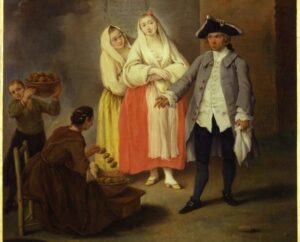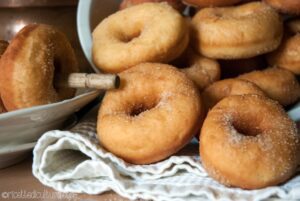
“Poor and gentleman’s morsel”, as the fritoleri used to call it.
Venetian frittelle, fritole venexiane, are one of the most eagerly awaited desserts during the Carnival period, by young and old alike.
Everyone loves them, thanks to their various fillings: chocolate, ricotta cheese, pistachio or empty, Venetian-style (pine nuts, sultanas and sugar-coated sultanas are also mixed into the dough…). They are fried and delicious!
They can still be found on the stalls of the fritoleri, the pancake sellers, around the city and in the most famous areas where masks and artists gather for Carnival.
How were the original frittelle in Venice?
They were born in the mid-14th century and the recipe is preserved in the Museo Nazionale Canatese in Rome. It later became the national dessert of the Serenissima Repubbica in 1700. There are several written records, preserved in the State Archives, near the Frari Church, on the field of the same name.
As found in the texts of the time, the recipe of the time included the addition of lard instead of oil, the use of goat’s milk and the addition of saffron (from the East) to the dough.
Nowadays, they can also be found around the city in pastry shops; whereas at one time they were prepared in the streets by fritoleri in small wooden huts (caselli) and sold hot. In the 17th century, they formed an association, made up of seventy of them, each with their own area where they could carry out their business exclusively and with the guarantee that only their children could succeed them: it was a family tradition.
This guild remained active until the fall of the Lagoon Republic, although the art of the ‘fritoleri’ only disappeared from the Venetian calli at the end of the 19th century.

Historians say that fritoleri used to knead frittelle, made with eggs, flour, sugar, sultanas and pine nuts, on large wooden tables. Then they would fry them in oil or lard, in huge pans supported by tripods. Once they were ready, they were sprinkled with sugar and placed on large decorated plates. At their side, on other plates, the ingredients were displayed in full view in order to emphasise the genuineness of the product.
Local recipes spread throughout the Veneto region, with fritters made with fruit dipped in batter or with flowers or vegetables, in some cases even with wild meadow and mountain herbs, and even with rice and polenta.
The ‘fritola‘ came to have an impact on the Jewish cuisine, which prepared a variation for Purim.
Venetian fritters find an important testimony in a famous 18th century painting by Pietro Longhi, the ‘Venditrice di Frittole‘, visible at Ca’ Rezzonico, in which doughnut-shaped fritters are cooked and served strung on a spit to be eaten while strolling through the city’s calli. Here is an example of a Venetian street food dessert you absolutely must try!